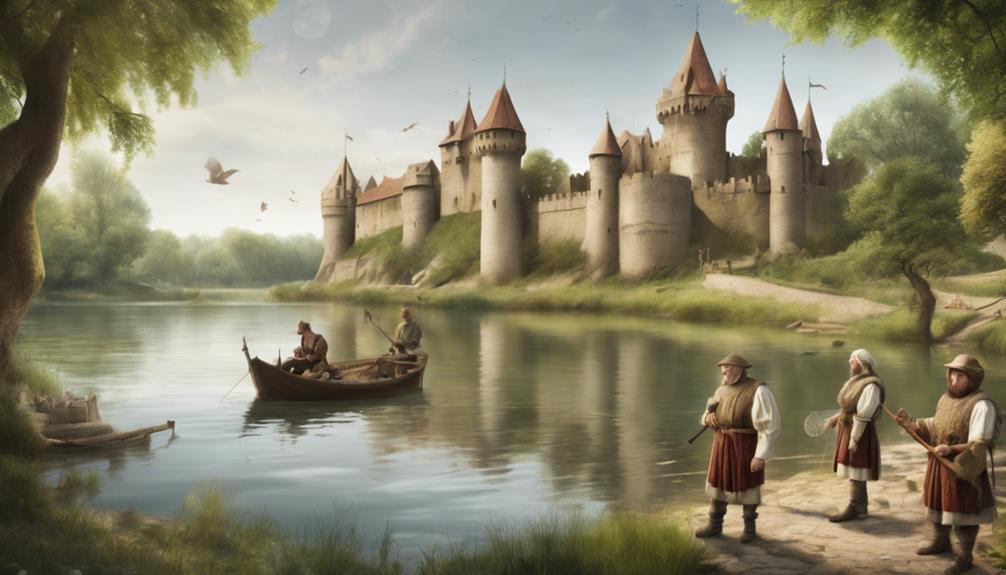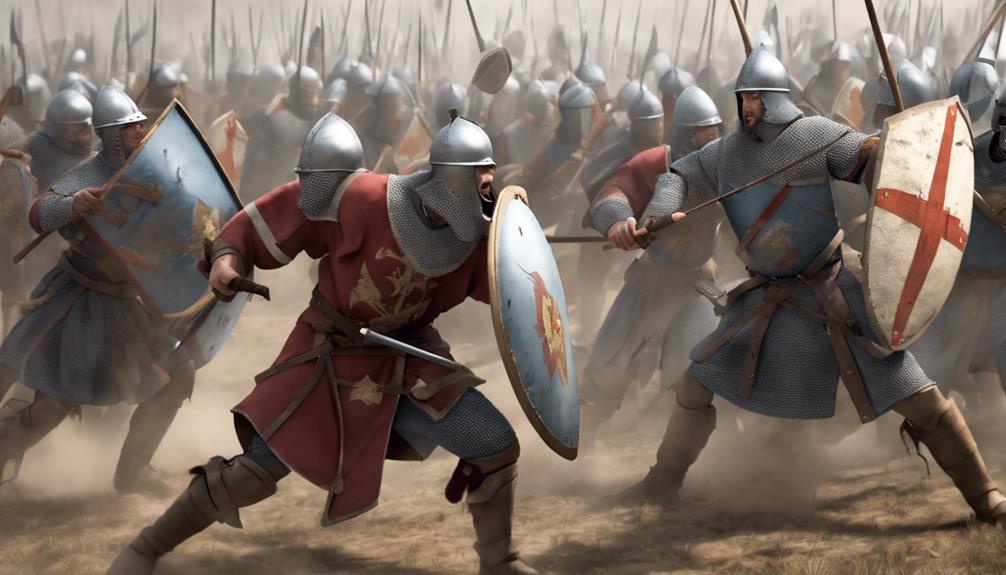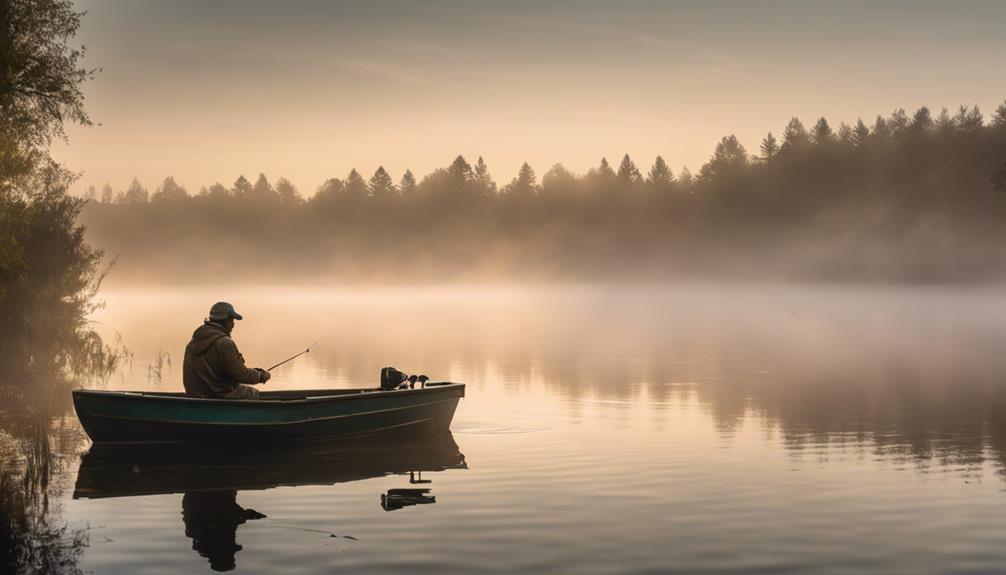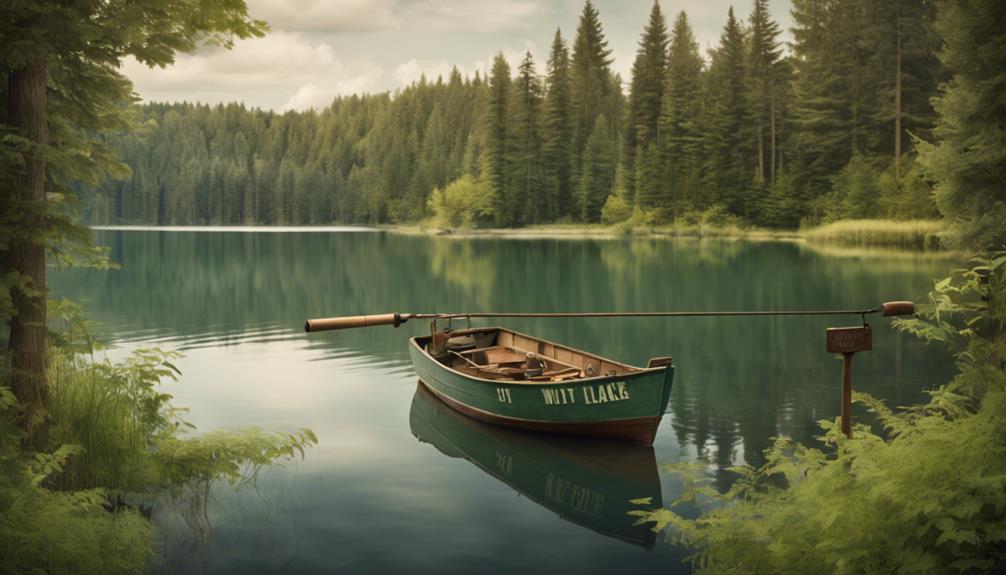Step into the fascinating realm of medieval fishing and angling, where ancient practices merged with regional techniques to form a unique tapestry of sustenance and culture. From handlines and natural baits in England to sophisticated methods like the 'trabucco' in the Mediterranean, diverse tools and traditions shaped this historical pursuit. Discover how fishing not only provided food but also influenced social status, with laws enforcing responsible practices. Explore the targeted fish species and the evolution of equipment, reflecting a blend of tradition and innovation. Uncover the lasting legacy of medieval angling on modern fishing culture.
Origins of Angling Techniques
During the medieval period, angling techniques evolved significantly, influenced by various cultures and technological advancements. Fishing traditions played a pivotal role in shaping these techniques. In medieval Europe, fishing wasn't just a means of sustenance but also a recreational activity enjoyed by nobles and commoners alike. Historical techniques were diverse, reflecting the different fishing traditions of regions across Europe.
In England, for example, angling was practiced using simple equipment like handlines or rods made from branches. The use of natural baits such as worms or insects was common among anglers aiming to catch freshwater fish like trout or pike. In contrast, Mediterranean regions like Italy had a long-standing tradition of using more sophisticated methods like the 'trabucco,' a wooden fishing platform extending over the sea, allowing fishermen to catch a variety of marine species.
Technological advancements also played a crucial role in the evolution of angling techniques during the medieval period. The development of more efficient hooks and lines made it easier for anglers to target specific fish species. Additionally, the use of floats made from materials like cork improved the visibility of bites, enhancing the overall fishing experience.
Popular Medieval Fishing Tools
Medieval fishing enthusiasts relied on a variety of tools to enhance their angling experience and increase their chances of a successful catch. Fishing hooks were one of the most common tools used during this era. These hooks were typically made of bone, iron, or bronze and varied in size depending on the type of fish being targeted.
Nets were also widely utilized for fishing in medieval times. Fishermen would cast these nets into the water to trap fish in large quantities, providing a more efficient way of catching fish compared to using hooks.
Spearfishing was another popular method employed by medieval anglers. This technique involved using a spear to catch fish in shallow waters. The skill and precision required for spearfishing made it a favorite among those looking for a challenge.
Trapping was also a prevalent fishing tool during this period. Fishermen would set up traps made of woven baskets or other materials to capture fish as they swam by.
Role of Fishing in Medieval Society
Fishing played a significant role in the societal fabric of the Middle Ages, intertwining with economic, dietary, and cultural aspects of daily life. In medieval society, the economic impact of fishing was far-reaching. Fishermen provided a vital food source for both the common folk and the nobility, contributing to the stability of the food supply. The ability to fish often correlated with social status, with those who owned fishing rights or boats holding a higher position in the social hierarchy.
Beyond its economic importance, fishing held cultural significance in medieval society. It wasn't only a means of sustenance but also a leisure activity enjoyed by people across various social classes. Fishing allowed individuals to connect with nature, escape the confines of daily life, and partake in a beloved pastime. Moreover, fishing practices were often intertwined with religious beliefs and rituals, further emphasizing its cultural value.
Engaging in fishing wasn't merely a practical necessity but a way to unwind, socialize, and appreciate the natural world. As such, fishing ponds and rivers became popular gathering spots where people could bond over a shared love for angling. The act of fishing in medieval times went beyond catching fish; it embodied a harmonious blend of economic utility, social stratification, and cultural enrichment.
Fish Species Targeted for Angling
Targeting a diverse array of fish species for angling purposes provided medieval communities with both sustenance and leisure opportunities. Trout fishing was a popular activity, especially in rivers and streams where these fish were abundant. The challenge of catching trout in clear waters using handmade flies or baited hooks added an element of skill and excitement to the angling experience. Carp angling was also prevalent, with these large freshwater fish being prized for their size and strength, providing a rewarding catch for medieval anglers.
Salmon sport was another favored pastime, particularly in regions where these migratory fish were plentiful. Anglers would eagerly await the salmon runs, timing their fishing trips to coincide with the peak season for these prized catches. The thrill of hooking a powerful salmon and the ensuing battle to reel it in made salmon fishing a cherished pursuit among medieval fishing enthusiasts.
Pike fishing was esteemed for the predatory nature of this species, known for its aggressive strikes and formidable size. Anglers would use a variety of techniques to entice pike, often employing live bait or lures to attract these voracious predators. The challenge of outsmarting and landing a pike added an element of adventure to medieval angling expeditions, making it a sought-after target for fishermen seeking a formidable opponent in the waters.
Fishing Regulations and Laws
Regulations and laws governing angling practices were established to ensure sustainable fishing practices and protect fish populations in medieval times. Fishing conservation was a key concern even centuries ago, with rules in place to prevent overfishing and preserve aquatic ecosystems. These regulations aimed to maintain a balance between human needs and environmental impact, recognizing the importance of fish populations for both sustenance and ecosystem health.
Poaching and illegal fishing practices were strictly prohibited under medieval fishing laws. Authorities enforced these regulations to safeguard fish stocks and prevent the depletion of valuable species. Poaching, which involved unauthorized fishing in restricted areas or using prohibited methods, posed a significant threat to fish populations and their habitats. By implementing laws against such activities, medieval societies sought to maintain the integrity of their water resources and ensure the continuity of fishing for future generations.
In essence, fishing regulations and laws in medieval times were designed to promote responsible angling practices, protect fish populations from exploitation, and safeguard the delicate balance of aquatic ecosystems. These early efforts in fishing conservation set a precedent for future generations to recognize the importance of sustainable fishing practices and the need to preserve marine life for the well-being of both humans and the environment.
Influence of Religion on Angling
Throughout medieval times, the practice of angling was intricately intertwined with religious beliefs and rituals, shaping the way individuals approached fishing and its significance in their spiritual lives. Religious ceremonies often involved fishing as a symbolic act, representing themes of abundance, sustenance, and even miracles. Fishing wasn't only a means of sustenance but also a way to connect with the divine through the act of providing for oneself and others.
In medieval society, fishing wasn't just a practical activity but a spiritual one as well. Many individuals believed that fishing allowed them to commune with nature and the spiritual world, fostering a deeper connection to the divine. Religious ceremonies frequently incorporated fishing as a metaphor for faith, patience, and abundance. The act of angling was seen as a way to reflect on one's place in the world and their relationship with higher powers.
Moreover, the act of fishing was often imbued with spiritual significance, with individuals viewing the fish they caught as gifts from the divine. This perspective created a sense of reverence for the creatures of the water and reinforced the idea of stewardship over the natural world. Overall, the influence of religion on angling in medieval times highlights the deep spiritual connections that individuals saw in the practice of fishing.
Evolution of Fishing Equipment
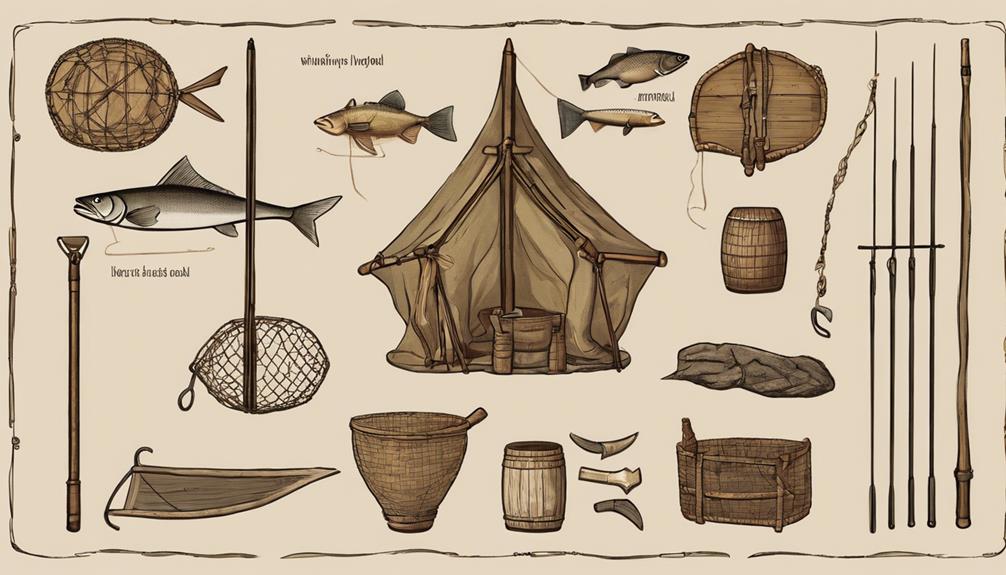
Over time, advancements in technology and craftsmanship have led to significant developments in the design and functionality of fishing equipment used by anglers in different historical periods. These changes reflect not only technological advancements but also the cultural significance of fishing traditions.
- Technological Advancements: The evolution of fishing equipment has been greatly influenced by technological advancements. From the rudimentary tools used in early civilizations to the sophisticated gear of modern times, innovations like carbon fiber rods, high-tech reels, and sonar fish finders have revolutionized the way anglers fish. These advancements haven't only made fishing more efficient but also more enjoyable for enthusiasts.
- Cultural Significance: Fishing traditions play a crucial role in shaping the design of fishing gear. Different cultures have distinct preferences when it comes to fishing equipment, influenced by factors such as local fish species, fishing techniques, and traditional practices. For example, the design of fishing rods used in fly fishing reflects the cultural heritage of the sport, with specific materials and construction methods being favored by different regions.
- Adaptation and Innovation: The evolution of fishing equipment is a testament to human adaptability and innovation. As anglers faced new challenges and opportunities, they developed new tools and techniques to enhance their fishing experience. This constant cycle of improvement has led to a diverse range of fishing gear available today, catering to different preferences and styles of fishing.
Legacy of Medieval Angling Practices
Examining the enduring influence of medieval angling practices reveals a rich tapestry of techniques and traditions that have shaped modern fishing culture. The cultural significance of these historical methods is evident in how they laid the foundation for contemporary angling practices. Medieval anglers employed various methods such as handlining, netting, and the use of simple hooks and baits, which are still prevalent today. These techniques not only provided sustenance but also shaped a recreational activity that has stood the test of time.
The legacy of medieval angling practices extends beyond the methods themselves. The principles of patience, observation, and understanding of aquatic ecosystems that were essential for successful fishing in medieval times continue to be valued in modern angling. Moreover, the respect for nature and the tradition of catch-and-release, although not universal in medieval times, have become integral to the ethos of responsible fishing today.
Technological advancements have certainly revolutionized angling practices, with modern equipment such as advanced reels, sonar technology, and synthetic baits enhancing the efficiency and effectiveness of fishing. However, the core principles instilled by medieval angling practices remain steadfast. The blend of tradition and innovation is a testament to the enduring influence of medieval fishing techniques on contemporary angling culture.
Frequently Asked Questions
Were There Any Fishing Superstitions or Rituals in Medieval Times?
In medieval times, fishing superstitions and rituals were deeply ingrained in the culture. People believed in folklore traditions passed down through generations. Ancient practices such as offering a catch to the sea gods were common.
Superstitions like not whistling while fishing or using specific bait for good luck were prevalent. Rituals before setting out to fish, like saying a prayer for a bountiful catch, were also observed. These beliefs added a mystical element to the art of fishing.
How Did Medieval Anglers Deal With Environmental Challenges?
When facing environmental challenges, medieval anglers had to adapt their techniques to ensure successful fishing. They employed various environmental adaptations, such as changing fishing locations based on weather patterns or adjusting bait types according to water conditions.
Resource management was crucial, as they needed to balance the fish population with sustainable fishing practices to maintain a healthy ecosystem.
What Were the Cultural Beliefs Surrounding Fish in Medieval Society?
In medieval society, fish held significant cultural beliefs. They were often seen as symbols of purity, fertility, and abundance, reflecting religious significance.
Fish consumption wasn't only a culinary practice but also tied to religious fasting traditions. The act of fishing and the presence of fish in art and literature symbolized deeper spiritual meanings.
Were There Any Famous Medieval Fishing Tournaments or Competitions?
Famous medieval fishing tournaments or competitions weren't uncommon. Noble anglers often showcased their skills in these events, seeking prestigious prizes and royal sponsorship. These competitions weren't just about fishing prowess but also displayed the wealth and status of participants.
Medieval fishing techniques were honed and showcased during these tournaments, attracting spectators from far and wide. The allure of these events extended beyond the mere act of fishing, evolving into grand displays of skill and opulence.
Did Medieval Anglers Use Any Special Techniques for Night Fishing?
When fishing at night during medieval times, anglers often relied on torchlight to illuminate the waters. Understanding moon phases was crucial for optimal fishing success.
Anglers carefully selected bait based on the specific fish species they were targeting. Nighttime strategy involved patience, stealth, and precision in casting.
Conclusion
Overall, delving into the historical fishing and angling practices of medieval times provides a fascinating glimpse into the intricate techniques, tools, and societal roles associated with this essential activity.
From the evolution of fishing equipment to the influence of religion and the targeted fish species, the legacy of medieval angling practices continues to shape modern fishing culture.
By understanding the origins and significance of fishing in medieval society, we can appreciate the rich history and traditions that have been passed down through generations.
